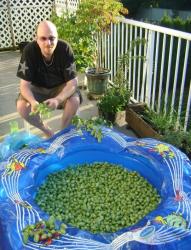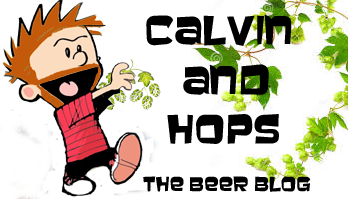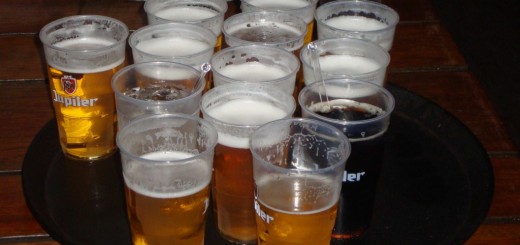Craft Brew, Home Brew, who’s feeding who’s growth?
A few days ago, someone asked me if I thought the rise in home brewing popularity was because of the current Craft Beer boom, or vise versa. Wow, what a loaded question – I believe that the two are intrinsically and inextricably linked, and yet two totally different conversations… I don’t even know where to begin…
A lot of different people get into home brewing for a lot of different reasons. For some it’s simple economics… making your own beer is cheaper than going to the liquor store. For others, it’s a stick in the ribs to the government; once they realize that over 60% of the price of a beer is taxation, they’d rather spend four hours over a boiling cauldron than fork over another red penny. In my experience though, as the operator of a Brewing Supply shop in Chilliwack, the vast majority of home brewers fall into three broad categories that all intersect and have an overlapping ethos at one point or another: Locavores, Purists, and Hackers.
The first category spans a wide swath of movements that have been building for decades; whether they identify as Farm to Table, Buy Local, 100 Mile Diet, Locavore, Bioregionalist, Sustainable Living, Foodscapers, or a host of other labels, these home brewers reject mass produced consumable goods with massive carbon footprints in favour of local sustenance. They support their local economies over foreign interests, favour sustainable living over mass consumerism, and genuinely care about the environment. By brewing their own beer, they are helping to heal the planet instead of helping to destroy it.
Similarity, the second category also cares greatly for the planet, but more-so for what they put into their own bodies. We’ve always had health scares when it comes to our mass produced food, whether it be red dye 40, MSG, polyunsaturated fats or pesticides, but in recent years the tsunami of reports about the evils of GMOs, high fructose corn syrup, antibiotics and preservatives has spawned many new Healthy Living movements. The push to “go organic”, “read labels”, “if you can’t pronounce it, don’t eat it” has a huge following. And let’s face it, if you’re trying to avoid GMOs, HFCS, adjuncts and preservatives, the popular macro-brewed beers are some of the worst offenders. With home brewing, you know EXACTLY what’s going into your body: Barley malt, hops, yeast, and water. That’s it. And, as if that weren’t enough, certified organic malts and hops are readily available too. As a lifestyle change that can make you feel good about what you’re consuming while allowing you to still keep beer in your diet AND saves you upwards of 75% over the commercial price, it’s a pretty compelling “feel good” choice to go home brew.
Then there are the Life Hackers, and I count myself in this category – at least that’s why I originally started home brewing – though I now identify greatly with the other two (see? That’s the inextricable overlap I was talking about). Hackers, tinkerers, inventors, innovators, The DIY movement, ‘reduce reuse recycle’, even the Hipster movement all have it in common – On one hand it may be a rejection of the consumer culture that entices someone to try to do something on their own, but on the other hand, there are those of us that NEED to know how things work. 99.99% of the planet accepts that airplanes fly, cars drive and lights go on when you flick a switch, but they don’t know (or care to know) why. The Hackers need to know. I’ve researched and built batteries, radios, amplifiers, even a solar panel array and charge controllers simply because the thought crossed my mind “If we ever got hit by a solar flare or an electromagnetic pulse weapon, or for any other reason all power was down for an extended period of time, what would I do?” Similarly, the though that there are such tight government restrictions on the manufacture of beer, wine, and spirits compelled me to learn how to brew, vint, ferment, and distill. What if there’s another prohibition? What if we run out of oil and there’s no more goods transported to remote communities, will there still be beer? Wine? There will be if I’ve got anything to do with it! Hackers need to know. Some take apart car engines and rebuild them to be even better. Some design ultralight DIY aircraft to prove that civilians can have the power of flight, some need to figure out how computer programs or electronics work, and some need to know if they can reproduce their favorite commercial beer on the home brew scale.
Then the magic happens. Regardless of which motivating factor drove the home brewer to commence their hobby, before long they all start having intersecting thoughts: “This is so much healthier”, “This is so much cheaper”, “This is so much better for the environment”, “This tastes so much more fresh and vibrant” than what I was drinking before! And then it hits them: “I once was blind, but now I see”.
So, the home brew movement has been growing since the early 70’s, but what explains it’s current explosion? For that we need to look at the Craft Beer explosion – not because one caused the other, but more accurately, they’re in a feedback loop – feeding off each other, they’re both fueling each other’s growth.
Remember in the 80’s and 90’s how us Canadians would mock American beer? It was yellow fizzy water with virtually no alcohol – in fact, they used slogans like “It’s the Water”, which only made us laugh more “It IS water!”. Well, while us 20 million Canadians were making fun of the 80% of America that enjoyed yellow fizzy water, there were still 20% of them, or about 50 million that were equally if not more disgruntled, and were actively working to change the status quo. They were the locavores, purists, and hackers of the day, they had discovered that REAL beer is awesome, and that there MUST be a market for it. While we were laughing at Rainier and Olympia, and crushing cans of 5% ABV Molson Canadian in a brief moment of national superiority complex, those crafty American home brewers were changing the world. By the end of the 90’s there were 3500 new Craft breweries in the US. Canada had less than ten. Twenty years later, we had definitely stopped laughing. In fact, the new Craft beer flooding the US (and eventually into Canada), spawned by the world changing dreams of lowly home brewers, was actually starting a new movement of its own. As more and more of the ‘other’ 80% ‘of Americans started tasting the fresh and wonderfully vibrant craft beers, more and more people wanted to know how it was done, and how they could make their own.
The growth in the home brewing scene in Canada did parallel that in US, although home brewing in Canada had a long jump-start on our southern counterparts. Until 1978 home brewing was not legal in America. Canadians had been doing it for a century, although supplies were extremely limited; but after legalization in the US in 1978 everything changed – Thanks to the book “Joy of Brewing” (1976) and Charlie Papazian’s book Complete Joy of Home Brewing (1984), the movement began to blossom. Craft Brewers tackled new styles, consumers loved them, and many wanted to ‘hack’ (try to re-create) them. Home brew supply shops popped up to cater to the new home brew demand, and started importing hops and malts from the UK and Germany. As ingredients came to be more readily available, home brewer and craft brewers alike began experimenting more, and a true symbiotic feedback loop emerged. Craft breweries began sponsoring home brew competitions – winner gets to brew a commercial batch, or gets a production run of their recipe. As more consumers got exposed to more new craft beer styles, more home brewers started searching for the next new thing. The more new things home brewers were coming up with, the more inspiration craft brewers got.
Craft brewers started digging deep into history for inspiration and began resurrecting ancient and extinct beer styles. Voracious for “anything new”, consumers literally gobbled it up. Even as recently as two years ago, I had never heard of Kvass, Purl, Gose, or Sahti – yet now I have not only tasted multiple takes on all of them, but have attempted to brew most of them.
And that’s the feedback loop that is generating more and more interest in Craft beer and in Home brewing. In B.C. Licensed craft breweries are increasing in number by about 20% a year, and a surprisingly high number of those breweries started as the lofty dream of a home brewer. For every Craft brewer who’s dream becomes a reality, 100 more home brewers are born.
Here in Chilliwack, I’ve seen the number of home brewers double every year for the past three years.
Who’s feeding who? The answer is BOTH. How far can this growth continue? Only time will tell. But many point to the San Francisco phenomenon as proof that an exponential rate of new brewery openings is sustainable; in the year 1900, thirty-four breweries existed in San Francisco. The city’s population at that time was 343,000. That’s one brewery per 10,000 residents. One hundred and ten years later, as the population of San Francisco has increased, there is now one brewery for every 59,000 people. A consumption driven capitalist might argue that increased productivity, cheap foreign ingredients and streamlined shipping avenues have made it possible to supply a greater area from the same small number of factories, while a locavore, purist, or hacker might argue that the same population could support six times the number of breweries more sustainably, while keeping more money in the local economy.
Will Home Brewing be the impetus to bring balance back to our society? Will it be one small step toward a cultural change for the better? It might not be the only thing, but it’s one thing. And if you could do just one thing to help cure the world, you could do worse than brew your own beer. And perhaps one day, after enough friends have told you how amazing your beer is, you too will take the plunge and join the ranks of BC’s Craft beer Brewers.


Latest posts by Calvin Quaite (see all)
- Craft Brew, Home Brew, who’s feeding who’s growth? - September 25, 2014
- What is a pint worth? - July 10, 2014
- Kid Friendly Craft Beer Establishments in British Columbia - July 7, 2014


Recent Comments